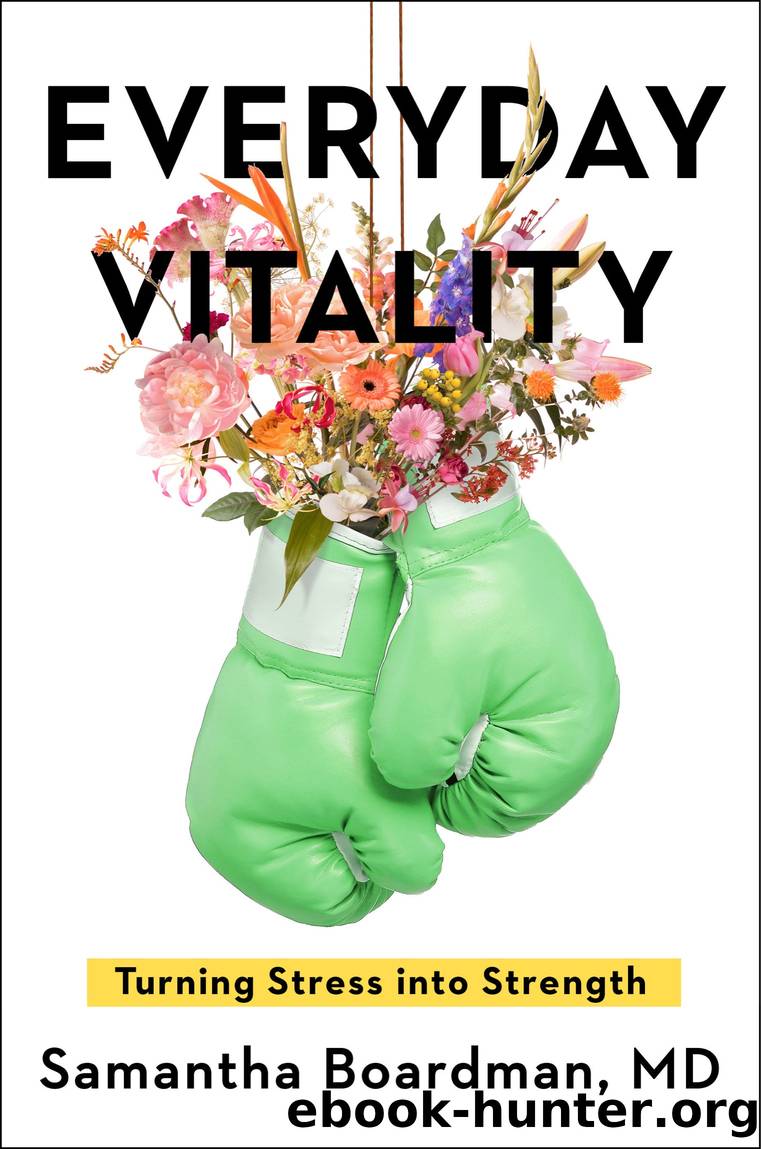Everyday Vitality by Samantha Boardman

Author:Samantha Boardman [Boardman, Samantha]
Language: eng
Format: epub
Publisher: Penguin Publishing Group
Published: 2021-08-10T00:00:00+00:00
Discomfort Is Data
One myth about emotionally healthy individuals is that they donât get sad or angry. Or if they do, theyâve learned how to grin and bear it. When someone cuts these people off on the highway, they smile. When their boss gives them a new project on a Friday afternoon thatâs due on Monday, they respond, âNo problem!â Although suppressing emotions is effective at stifling a potentially harmful impulsive reaction like punching the wall or getting into a fight over a parking space, itâs actually not a healthy long-term strategy for managing negative emotions. Habitual suppression comes at a real cost, most likely increasing the risk of dying from heart disease and even certain forms of cancer. Nor is it good for mental health. Suppressors are also more likely to be depressed and to lack social support.
Emotionally healthy people donât avoid negative feelings. They accept these emotions as a normal part of life and use them as valuable information. A certain amount of emotional discomfort alerts us that something isnât quite right and requires attention and possibly action. When used effectively, negative emotions can prompt us to change our behavior and help us to guide a situation in a new direction. (Think Miss Clavel from the childrenâs book Madeline who, in the middle of the night, turns on a light and declares, âSomething is not right.â This feeling prompts Miss Clavel to race to the dorm, where she discovers that Madeline is in medical distress.)
Mike, age forty-one, came to see me after splitting up with his girlfriend. At the beginning of the first few sessions, before I was even able to say a word, he would jump in, filling me in on the details of the week: what he had done, how many miles he had run, whom he had had dinner with, and so on. He talked at me, not with me, snowing me with the minutiae of his life. When he did describe his breakup, he didnât seem particularly sad, even though it was the fourth relationship in five years that had gone sour. He was feeling frustrated but determined not to let the split bring him down. Mike didnât want to talk about his current emotional state. He wanted to focus on the future.
âWhatâs the point of talking about it? Whatâs done is done,â he said. He portrayed himself as a master of moving on. âIsnât that healthy?â he asked. He had already gone on two dates. He had joined a cold-water swimming group and was training for the marathon. Unwilling to confront his sadness, he much preferred to keep moving, literally and emotionally.
Mike was correct to believe that ruminating can leave someone stuck in a relentless cycle of distress. But he was also a rationalizer, insisting, âShe wasnât right for me in the first place.â Rationalizing protected him from dealing with unpleasant emotions and feeling bad about himself, but it also prevented him from gaining any insight that would prevent his next relationship from repeating this same pattern.
Download
This site does not store any files on its server. We only index and link to content provided by other sites. Please contact the content providers to delete copyright contents if any and email us, we'll remove relevant links or contents immediately.
Professional Troublemaker by Luvvie Ajayi Jones(29419)
Whiskey Words & a Shovel I by r.h. Sin(19189)
Rewire Your Anxious Brain by Catherine M. Pittman(18297)
Healthy Aging For Dummies by Brent Agin & Sharon Perkins RN(16919)
Cat's cradle by Kurt Vonnegut(14758)
Talking to Strangers by Malcolm Gladwell(12869)
The Art of Thinking Clearly by Rolf Dobelli(9910)
They Both Die at the End by Adam Silvera(9481)
The 5 Love Languages: The Secret to Love That Lasts by Gary Chapman(9277)
Doing It: Let's Talk About Sex... by Hannah Witton(9077)
The Compound Effect by Darren Hardy(8508)
Thirteen Reasons Why by Jay Asher(8451)
Goodbye, Things by Fumio Sasaki(8291)
Wonder by R.J. Palacio(8266)
Atomic Habits: Tiny Changes, Remarkable Results by James Clear(8046)
Becoming Supernatural by Dr. Joe Dispenza(7833)
Tools of Titans by Timothy Ferriss(7813)
Wonder by R. J. Palacio(7742)
Should I Stay or Should I Go? by Ramani Durvasula(7429)
